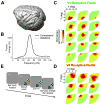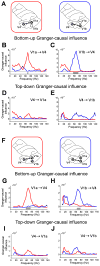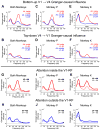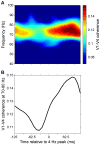Attentional stimulus selection through selective synchronization between monkey visual areas
- PMID: 22958827
- PMCID: PMC3457649
- DOI: 10.1016/j.neuron.2012.06.037
Attentional stimulus selection through selective synchronization between monkey visual areas
Abstract
A central motif in neuronal networks is convergence, linking several input neurons to one target neuron. In visual cortex, convergence renders target neurons responsive to complex stimuli. Yet, convergence typically sends multiple stimuli to a target, and the behaviorally relevant stimulus must be selected. We used two stimuli, activating separate electrocorticographic V1 sites, and both activating an electrocorticographic V4 site equally strongly. When one of those stimuli activated one V1 site, it gamma synchronized (60-80 Hz) to V4. When the two stimuli activated two V1 sites, primarily the relevant one gamma synchronized to V4. Frequency bands of gamma activities showed substantial overlap containing the band of interareal coherence. The relevant V1 site had its gamma peak frequency 2-3 Hz higher than the irrelevant V1 site and 4-6 Hz higher than V4. Gamma-mediated interareal influences were predominantly directed from V1 to V4. We propose that selective synchronization renders relevant input effective, thereby modulating effective connectivity.
Copyright © 2012 Elsevier Inc. All rights reserved.
Figures








Comment in
-
Cognitive neuroscience: selection through synchrony.Nat Rev Neurosci. 2012 Nov;13(11):738. doi: 10.1038/nrn3358. Epub 2012 Sep 26. Nat Rev Neurosci. 2012. PMID: 23011392 No abstract available.
References
Publication types
MeSH terms
Grants and funding
LinkOut - more resources
Full Text Sources
Other Literature Sources

